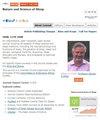The Association Between Sleep Problems and Attentional Network Functions in Patients with Self-Limited Epilepsy with Centrotemporal Spikes
IF 3
2区 医学
Q2 CLINICAL NEUROLOGY
引用次数: 0
Abstract
Purpose: To investigate sleep problems in children with self-limited epilepsy with central temporal spiking (SeLECTS) and to assess the relationship between sleep problems and attention network dysfunction. Patients and methods: 107 children 6–14 years of age with SeLECTS and 90 age-and sex-matched healthy controls were recruited for this study. The sleep status of these participants was evaluated using the Children’s Sleep Habits Questionnaire (CSHQ), while attentional network function was assessed with the attention network function test (ANT). Results: Together, these analyses revealed that children with SeLECTS exhibited higher total CSHQ scores and sleep disorder incidence relative to healthy controls (P< 0.001). Children with SeLECTS had higher scores in delayed sleep onset, sleep duration, night awakenings, parasomnias, daytime sleepiness and sleep anxiety (P<0.01). Total CSHQ scores were negatively correlated with average ANT correct rates ( ρ = −0.253, P<0.01), while they were positively correlated with total reaction time ( ρ =0.367, P<0.01) and negatively correlated with the efficiency of the alerting and executive control networks ( ρ =−0.344 P<0.01; ρ =−0.418 P<0.01). Conclusion: Children with SeLECTS face a higher risk of experiencing sleep disorders relative to age-matched healthy children, while also demonstrating that the magnitude of the impairment of attentional network function in these children is positively correlated with sleep disorder severity. Thus, the prognosis and quality of life of children with SeLECTS can be improved by interventions addressing sleep disorders.颞中棘自限性癫痫患者的睡眠问题与注意网络功能之间的关系
目的:调查自限性癫痫伴中央颞区棘波(SeLECTS)儿童的睡眠问题,并评估睡眠问题与注意力网络功能障碍之间的关系。患者与方法:本研究招募了 107 名 6-14 岁患有 SeLECTS 的儿童和 90 名年龄与性别匹配的健康对照者。使用儿童睡眠习惯问卷(CSHQ)对这些参与者的睡眠状况进行评估,同时使用注意力网络功能测试(ANT)对注意力网络功能进行评估。结果显示这些分析表明,与健康对照组相比,SeLECTS患儿的CSHQ总分更高,睡眠障碍发生率更高(P< 0.001)。患有 SeLECTS 的儿童在睡眠开始延迟、睡眠持续时间、夜间觉醒、寄生虫病、白天嗜睡和睡眠焦虑方面的得分更高(P<0.01)。CSHQ总分与ANT平均正确率呈负相关(ρ = -0.253,P<0.01),与总反应时间呈正相关(ρ =0.367,P<0.01),与警觉和执行控制网络的效率呈负相关(ρ =-0.344 P<0.01;ρ =-0.418 P<0.01)。结论与年龄匹配的健康儿童相比,患有 SeLECTS 的儿童面临更高的睡眠障碍风险,同时也表明这些儿童的注意网络功能受损程度与睡眠障碍的严重程度呈正相关。因此,针对睡眠障碍的干预措施可以改善 SeLECTS 儿童的预后和生活质量。
本文章由计算机程序翻译,如有差异,请以英文原文为准。
求助全文
约1分钟内获得全文
求助全文
来源期刊

Nature and Science of Sleep
Neuroscience-Behavioral Neuroscience
CiteScore
5.70
自引率
5.90%
发文量
245
审稿时长
16 weeks
期刊介绍:
Nature and Science of Sleep is an international, peer-reviewed, open access journal covering all aspects of sleep science and sleep medicine, including the neurophysiology and functions of sleep, the genetics of sleep, sleep and society, biological rhythms, dreaming, sleep disorders and therapy, and strategies to optimize healthy sleep.
Specific topics covered in the journal include:
The functions of sleep in humans and other animals
Physiological and neurophysiological changes with sleep
The genetics of sleep and sleep differences
The neurotransmitters, receptors and pathways involved in controlling both sleep and wakefulness
Behavioral and pharmacological interventions aimed at improving sleep, and improving wakefulness
Sleep changes with development and with age
Sleep and reproduction (e.g., changes across the menstrual cycle, with pregnancy and menopause)
The science and nature of dreams
Sleep disorders
Impact of sleep and sleep disorders on health, daytime function and quality of life
Sleep problems secondary to clinical disorders
Interaction of society with sleep (e.g., consequences of shift work, occupational health, public health)
The microbiome and sleep
Chronotherapy
Impact of circadian rhythms on sleep, physiology, cognition and health
Mechanisms controlling circadian rhythms, centrally and peripherally
Impact of circadian rhythm disruptions (including night shift work, jet lag and social jet lag) on sleep, physiology, cognition and health
Behavioral and pharmacological interventions aimed at reducing adverse effects of circadian-related sleep disruption
Assessment of technologies and biomarkers for measuring sleep and/or circadian rhythms
Epigenetic markers of sleep or circadian disruption.
文献相关原料
| 公司名称 | 产品信息 | 采购帮参考价格 |
|---|
 求助内容:
求助内容: 应助结果提醒方式:
应助结果提醒方式:


